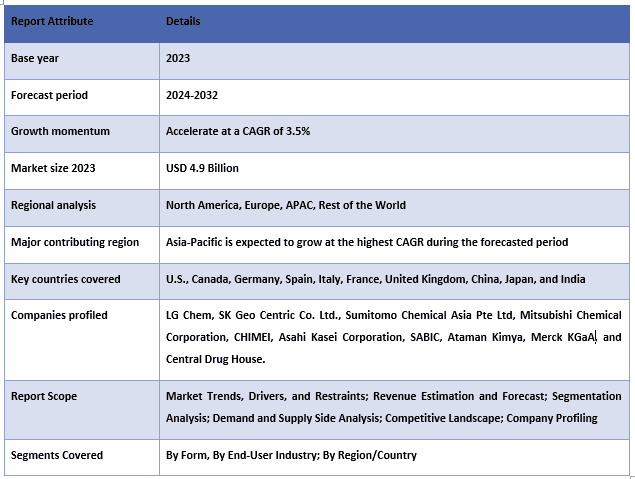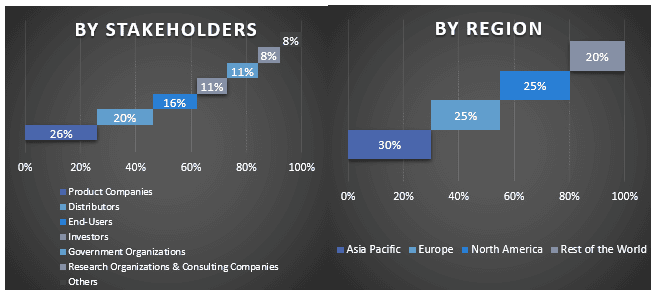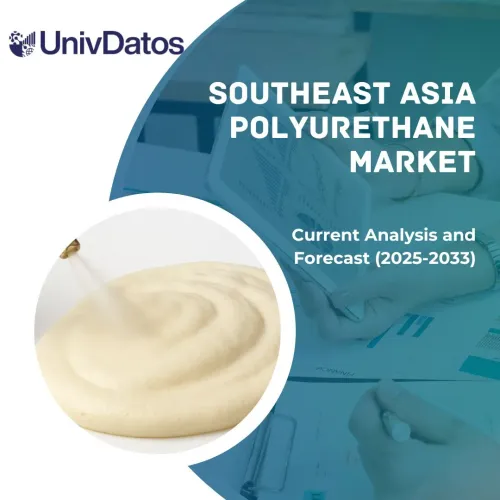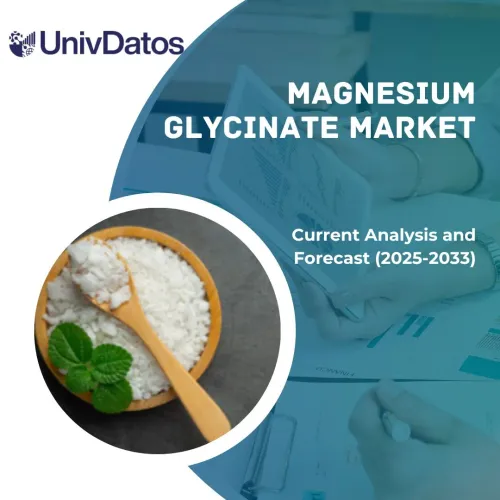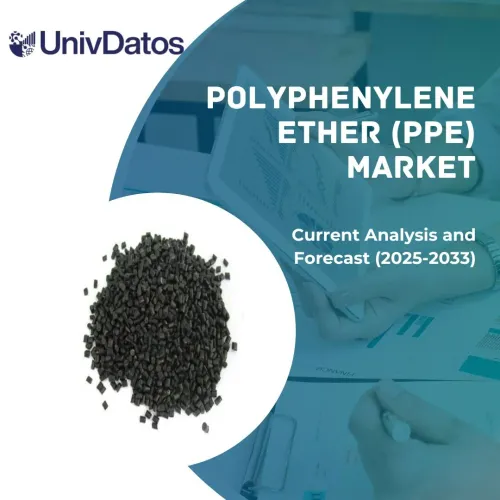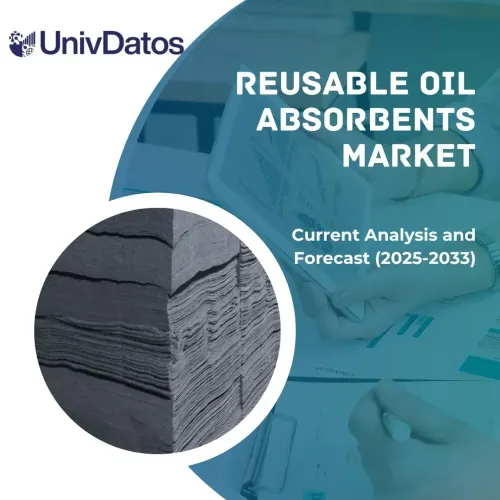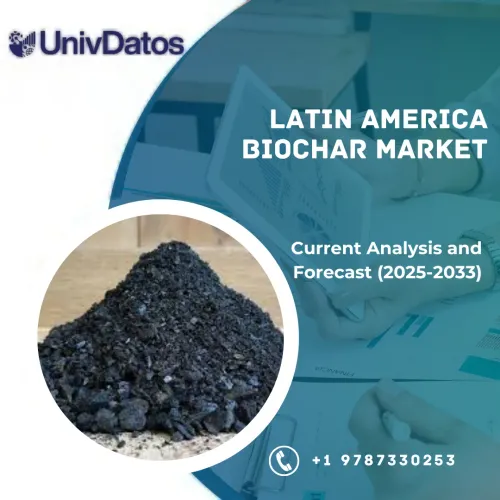- Home
- About Us
- Industry
- Services
- Reading
- Contact Us
Polymethyl Methacrylate (PMMA) Market: Current Analysis and Forecast (2024-2032)
Emphasis on Form (Extruded Sheets, Cast Acrylic Sheets, Pellets, Beads, And Other); By End-Use Industry (Sign & Displays, Automotive, Building & Construction, Lighting & Fixture, Marine, Healthcare, Consumer Goods, and Others), Region/Country.
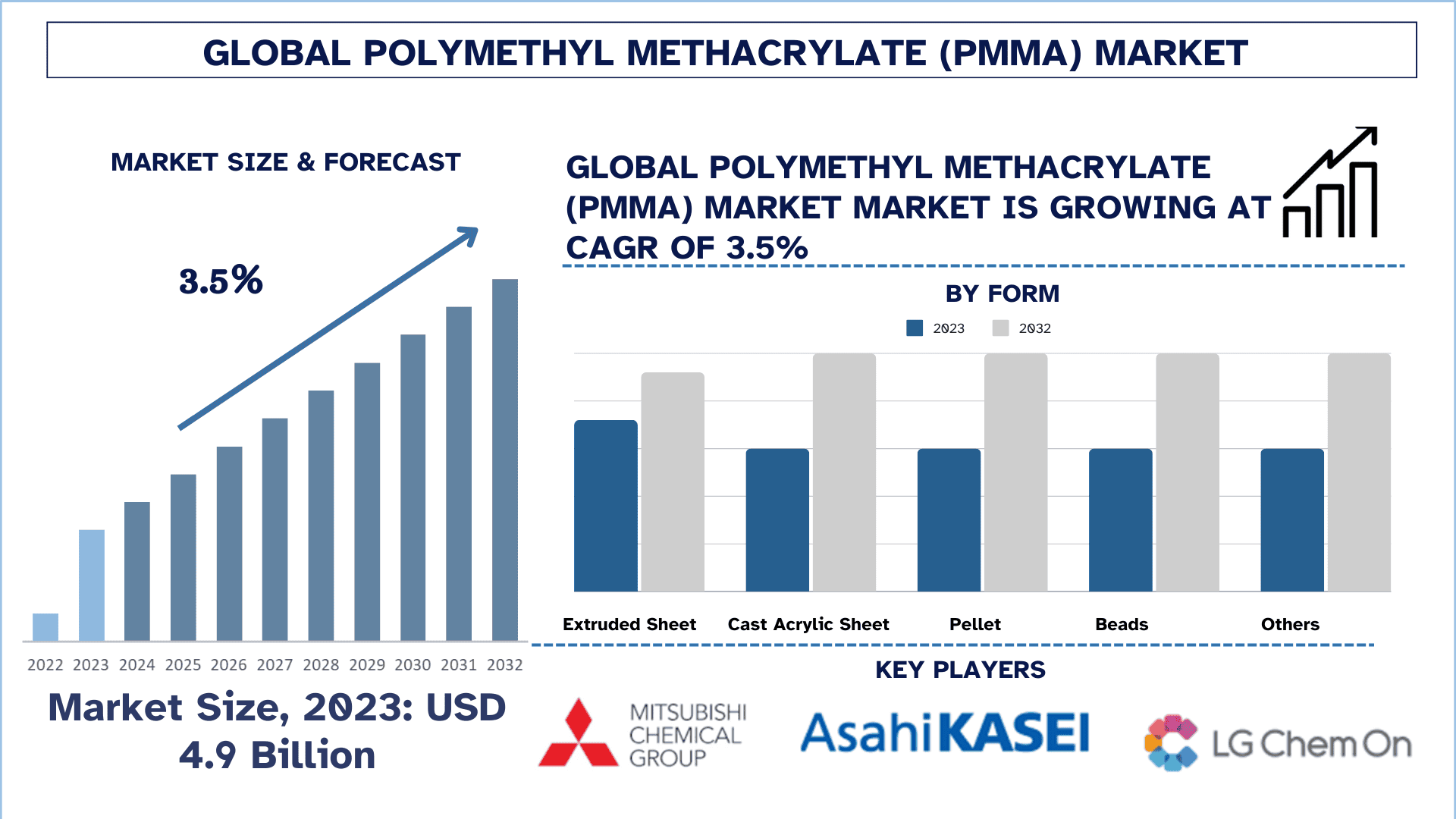
Polymethyl Methacrylate (PMMA) Market Size & Forecast
The Polymethyl Methacrylate (PMMA) Market was valued at USD 4.9 Billion in 2023 and is expected to grow at a strong CAGR of around 3.5% during the forecast period (2024-2032) owing to the growing demand for lightweight materials, growing expansion of automotive and renewable energy sector.
Polymethyl Methacrylate (PMMA) Market Analysis
The global Polymethyl Methacrylate (PMMA) Market is propelled by various sectors such as electronics, automotive, aerospace, energy and healthcare. PMMA has excellent properties with regards to mechanical, optical and thermal thereby serving as a very important material from automotive lighting to medical devices. Sustainability and energy efficiency also take at this time a significant role, albeit in additional markets such as electric vehicles (EVs) or renewable energy requiring lightweight yet durable materials. Among the automotive applications for PMMA are headlamp lenses and windows for vehicles, which benefit from the reduced weight and corresponding improved fuel efficiency-all other conditions being equal. PMMA is used in the production of windows and cockpit displays in aircraft as it is lightweight and transparent. Furthermore, PMMA is now widely used in the medical field for intraocular lenses and drug delivery systems. Reinforcement of market demand for PMMA takes hold as renewable energy technologies, particularly solar energy, are emphasized because they define durability and optical performance in solar panels.
Changes to the PMMA market are evident as breakthroughs, innovations, and collaborations within the industry pave new ways for improvement. For a major example, around 2024, one of the key global PMMA producers, Röhm GmbH, announced a tandem partnered venture with Covestro for the enhanced development of sustainable EDPM methods of PMMA production. This partnership also extends into the efficient performance of PMMA while minimizing the environmental detriment associated with PMMA manufacture. Shifts are manifesting in market dynamics with increased enthusiasm for sustainable practices such as recycling initiatives and the creation of bio-based PMMA products. On the demand side, rapid industrialization in most of the emerging economies is supporting PMMA product consumption. China, India, and South Korea have continued to investment massively on infrastructural development, urbanization, and advances in consumer technologies, contributing to more improvement in PMMA-related applications such as consumer electronics, automotive, and healthcare. Considering the demand for such materials in different industries the Polymethyl Methacrylate (PMMA) market is further anticipated to grow during 2024-2032.
Polymethyl Methacrylate (PMMA) Market Trends
This section discusses the key market trends that are influencing the various segments of the Polymethyl Methacrylate (PMMA) market as identified by our team of research experts.
3D Printing and Additive Manufacturing
3D printing and additive manufacturing are revolutionizing the PMMA market, opening new doors for personalization in production and complicated designs. PMMA is an excellent candidate for use in 3D printing applications due to properties such as optical clarity and durability as well as simplicity in processing. PMMA-based resins are rapidly coming into additive manufacturing, which is for industries requiring accuracy, transparency, and strength in their final products. The most advanced part in a PMMA 3D printing is the capability of creating forms and geometries that are difficult or impossible to be achieved by traditional methods. This becomes very valuable in healthcare (custom prosthetics and medical devices), automotive (prototyping and production components), and consumer electronics (unique product designs and functional parts).
As well as on-demand bespoke production, this is another factor leading to the growing use of PMMA primary propulsion in 3D printing, which also minimizes material wastage and gives scope to design variations. And in the future with the growing technology, PMMA in 3D printing is likely to increase presenting a more exciting opportunity for innovation across the board.
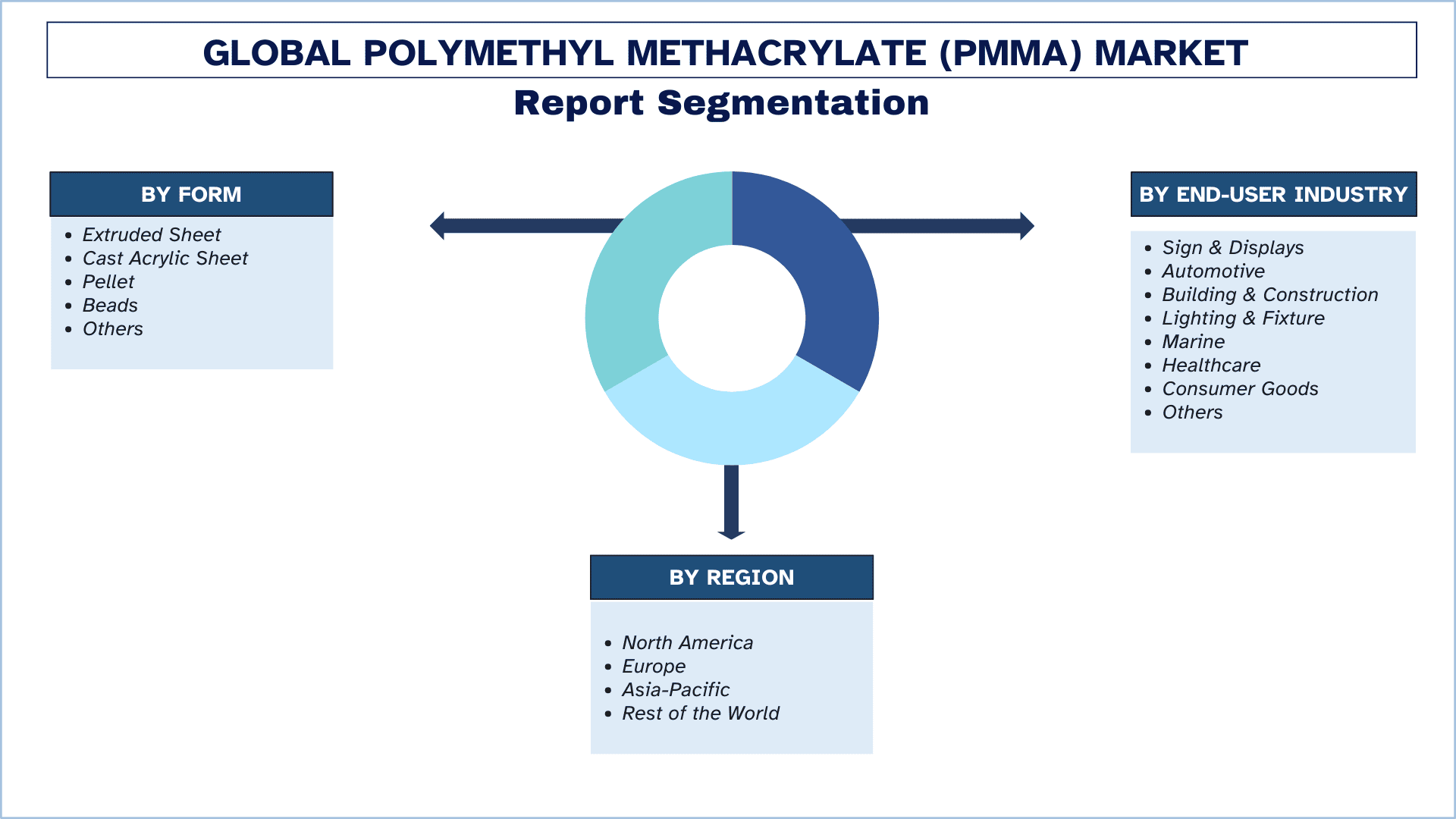
Asia Pacific is Expected to Grow with Significant CAGR During Forecast Period
While rapid industrialization and urbanization have been boosting demand in different end-use industries, the APAC zone is the fastest and largest market for Polymethyl Methacrylate (PMMA). Some of the primary countries such as China, India, South Korea, and Japan are developing in their production and consumption capabilities on account of expanding manufacturing sector and further developments on infrastructure on PMMA. Forefront automotive, electronics, and healthcare industries contribute largely towards the increasing use of PMMA in the region's construction industry.
The demand for lightweight materials such as PMMA in the automotive industry is fast growing due to the improved fuel economy and performance that it will bring about. PMMA finds its broadest applications in automotive lighting systems such as headlamps, taillights, and decorative parts due to its durability, optical clarity, and capability of withstanding harsh environmental conditions.
The renewable sector also grows within the Asia region, its installations continuously increasing, with solar energy producing the most MBAs, where PMMA is used as solar panel covers because of its excellent transparency, UV resistance, and durability. This also makes it efficient in increasing the life of solar panels and their efficiencies.
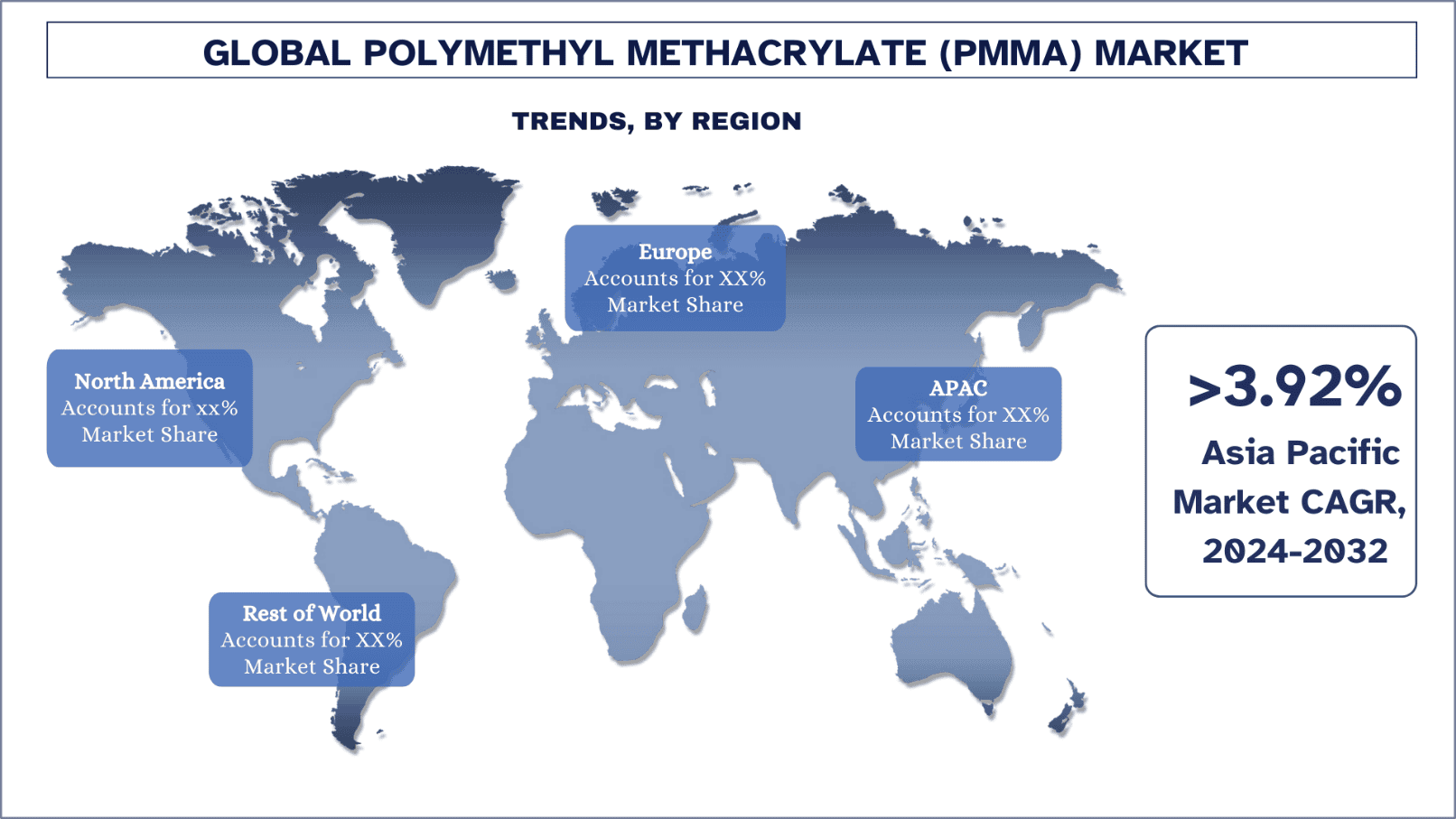
Polymethyl Methacrylate (PMMA) Industry Overview
The Polymethyl Methacrylate (PMMA) market is competitive and fragmented, with the presence of several global and international market players. The key players are adopting different growth strategies to enhance their market presence, such as partnerships, agreements, collaborations, new product launches, geographical expansions, and mergers and acquisitions. Some of the major players operating in the market include LG Chem, SK Geo Centric Co. Ltd., Sumitomo Chemical Asia Pte Ltd, Mitsubishi Chemical Corporation, CHIMEI, Asahi Kasei Corporation, SABIC, Ataman Kimya, Merck KGaA, and Central Drug House.
Polymethyl Methacrylate (PMMA) Market News
In 2023, a specialty material solution provider Trinseo announced to establish depolymerization plant in Italy enabling efficient recycling of PMMA-based materials.
Polymethyl Methacrylate (PMMA) Market Report Coverage
Reasons to buy this report:
- The study includes market sizing and forecasting analysis validated by authenticated key industry experts.
- The report presents a quick review of overall industry performance at one glance.
- The report covers an in-depth analysis of prominent industry peers with a primary
- focus on key business financials, product portfolios, expansion strategies, and recent developments.
- Detailed examination of drivers, restraints, key trends, and opportunities prevailing in the industry.
- The study comprehensively covers the market across different segments.
Deep dive regional level analysis of the industry.
Customization Options:
The global Polymethyl Methacrylate (PMMA) market can further be customized as per the requirement or any other market segment. Besides this, UMI understands that you may have your own business needs, hence feel free to contact us to get a report that completely suits your requirements.
Table of Content
Research Methodology for the Polymethyl Methacrylate (PMMA) Market Analysis (2024-2032F)
Analyzing the historical market, estimating the current market, and forecasting the future market of global Polymethyl Methacrylate (PMMA) were the three major steps undertaken to create and explore the adoption of Polymethyl Methacrylate (PMMA) in major regions globally. Exhaustive secondary research was conducted to collect the historical market numbers and estimate the current market size. Secondly, numerous findings and assumptions were taken into consideration to validate these insights. Moreover, exhaustive primary interviews were also conducted with industry experts across the value chain of the global Polymethyl Methacrylate (PMMA) market. Post assumption and validation of market numbers through primary interviews, we employed a top-down/bottom-up approach to forecasting the complete market size. Thereafter, market breakdown and data triangulation methods were adopted to estimate and analyze the market size of segments and sub-segments of the industry. Detailed methodology is explained below:
Analysis of Historical Market Size
Step 1: In-Depth Study of Secondary Sources:
A detailed secondary study was conducted to obtain the historical market size of Polymethyl Methacrylate (PMMA) through company internal sources such as annual reports & financial statements, performance presentations, press releases, etc., and external sources including journals, news & articles, government publications, competitor publications, sector reports, third-party database, and other credible publications.
Step 2: Market Segmentation:
After obtaining the historical market size of Polymethyl Methacrylate (PMMA), we conducted a detailed secondary analysis to gather historical market insights and share for different segments and sub-segments for major regions. Major segments are included in the report, such as by form and by end-user industry. Further country-level analyses were conducted to evaluate the overall adoption of testing models in that region.
Step 3: Factor Analysis:
After acquiring the historical market size of different segments and sub-segments, we conducted a detailed factor analysis to estimate the current market size of Polymethyl Methacrylate (PMMA). Further, we conducted factor analysis using dependent and independent variables such as by form and by end-user industry of Polymethyl Methacrylate (PMMA) market. A thorough analysis was conducted of demand and supply-side scenarios considering top partnerships, mergers and acquisitions, business expansion, and product launches in the Polymethyl Methacrylate (PMMA) sector across the globe.
Current Market Size Estimate & Forecast
Current Market Sizing: Based on actionable insights from the above 3 steps, we arrived at the current market size, key players in the global Polymethyl Methacrylate (PMMA) market, and market shares of the segments. All the required percentage shares split, and market breakdowns were determined using the above-mentioned secondary approach and were verified through primary interviews.
Estimation & Forecasting: For market estimation and forecast, weights were assigned to different factors including drivers & trends, restraints, and opportunities available for the stakeholders. After analyzing these factors, relevant forecasting techniques i.e., the top-down/bottom-up approach were applied to arrive at the market forecast for 2032 for different segments and sub-segments across the major markets globally. The research methodology adopted to estimate the market size encompasses:
The industry’s market size, in terms of revenue (USD) and the adoption rate of the Polymethyl Methacrylate (PMMA) across the major markets domestically
All percentage shares, splits, and breakdowns of market segments and sub-segments
Key players in the global Polymethyl Methacrylate (PMMA) market in terms of products offered. Also, the growth strategies adopted by these players to compete in the fast-growing market
Market Size and Share Validation
Primary Research: In-depth interviews were conducted with the Key Opinion Leaders (KOLs) including Top Level Executives (CXO/VPs, Sales Head, Marketing Head, Operational Head, Regional Head, Country Head, etc.) across major regions. Primary research findings were then summarized, and statistical analysis was performed to prove the stated hypothesis. Inputs from primary research were consolidated with secondary findings, hence turning information into actionable insights.
Split of Primary Participants in Different Regions
Market Engineering
The data triangulation technique was employed to complete the overall market estimation and to arrive at precise statistical numbers for each segment and sub-segment of the global Polymethyl Methacrylate (PMMA) market. Data was split into several segments & sub-segments post studying various parameters and trends in the areas by form and by end-user industry in the global Polymethyl Methacrylate (PMMA) market.
The main objective of the Global Polymethyl Methacrylate (PMMA) Market Study
The current & future market trends of the global Polymethyl Methacrylate (PMMA) market were pinpointed in the study. Investors can gain strategic insights to base their discretion for investments on the qualitative and quantitative analysis performed in the study. Current and future market trends determined the overall attractiveness of the market at a regional level, providing a platform for the industrial participant to exploit the untapped market to benefit from a first-mover advantage. Other quantitative goals of the studies include:
Analyze the current and forecast market size of Polymethyl Methacrylate (PMMA) industry in terms of value (USD). Also, analyze the current and forecast market size of different segments and sub-segments
Segments in the study include areas by form and by end-user industry
Define and analysis of the regulatory framework for the Polymethyl Methacrylate (PMMA) industry
Analyze the value chain involved with the presence of various intermediaries, along with analyzing customer and competitor behaviors of the industry
Analyze the current and forecast market size of the Polymethyl Methacrylate (PMMA) market for the major region
Major countries of regions studied in the report include Asia Pacific, Europe, North America, and the Rest of the World
Company profiles of the Polymethyl Methacrylate (PMMA) market and the growth strategies adopted by the market players to sustain in the fast-growing market
Deep dive regional level analysis of the industry
Frequently Asked Questions FAQs
Q1: What is the current market size and growth potential of the Polymethyl Methacrylate (PMMA) market?
The Polymethyl Methacrylate (PMMA) Market was valued at USD 4.9 Billion in 2023 and is expected to grow at a strong CAGR of around 3.5% during the forecast period (2024-2032).
Q2: What are the driving factors for the growth of the Polymethyl Methacrylate (PMMA) market?
The growing demand for lightweight materials from industries such as aerospace, automotive, renewable energy sector, etc., are some of the key factors attributing to the market growth.
Q3: Which segment has the largest share in the Polymethyl Methacrylate (PMMA) market by form?
The extruded sheet has the largest share of the Polymethyl Methacrylate (PMMA) market by form.
Q4: What are the emerging technologies and trends in the Polymethyl Methacrylate (PMMA) market?
3D Printing and Additive Manufacturing and Customization and Smart Polymers are some of the key trends observed in the Polymethyl Methacrylate (PMMA) market.
Q5: Which region will dominate in the Polymethyl Methacrylate (PMMA) market?
Asia Pacific is expected to dominate the market during the forecast period.
Related Reports
Customers who bought this item also bought

